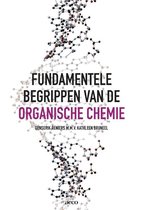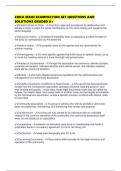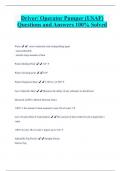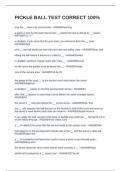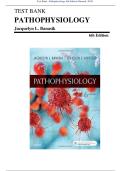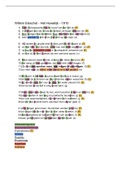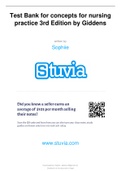Organische chemie
2e bachelor Handelsingenieur, 2e semester
Examen:
- Theorie + oefeningen
- PSE, tabel naamgeving (prioriteitenlijst)
- 50% theorie; 30% oefeningen en 20% practicum
- Leerstof: PowerPoint (boek is extra)
- Het schrijven van mechanisme in chemische structuren en NIET in volzinnen
,Inhoudsopgave
HOOFDSTUK 1 – INLEIDING..................................................................................................... 4
1.GESCHIEDENIS VAN DE ORGANISCHE CHEMIE......................................................................................... 4
2.WAAROM ZIJN ER ZOVEEL KOOLSTOFVERBINDINGEN?...............................................................................4
3.SCHRIJFWIJZE VAN HET KOOLSTOFSKELET............................................................................................... 5
4.ORGANISCHE STOFKLASSE..................................................................................................................... 5
5.ISOMERIE............................................................................................................................................. 6
HOOFDSTUK 2 – VEILIGHEID................................................................................................... 8
1.VEILIGHEID EN RISICO.......................................................................................................................... 8
1.1Definities...................................................................................................................................... 8
1.2Risicozandloper en risicotrias...................................................................................................... 8
1.3Kwanitficeren van risico.............................................................................................................. 8
1.5Risicomanagement....................................................................................................................... 9
1.6Persoonsgebaseerde veiligheid en gedragsgebaseerde veiligheid............................................10
1.7 TEAM-model voor veiligheidscultuur........................................................................................ 11
2.VEILIGHEID IN DE CHEMIE................................................................................................................... 11
2.1Risico’s met betrekking tot chemische stoffen..........................................................................11
2.2GHS-pictogrammen, CAS-nummers, P- en H- zinnen en RAMP.................................................12
2.3Ongevalsscenario’s.................................................................................................................... 12
2.5Risicomanagement in de chemie............................................................................................... 14
2.6Wetgeving.................................................................................................................................. 15
HOOFDSTUK 3 – KOOLWATERSTOFFEN................................................................................17
1.ALKANEN........................................................................................................................................... 17
1.1Naamgeving............................................................................................................................... 17
1.2Structuur.................................................................................................................................... 17
1.3Isomerie..................................................................................................................................... 18
1.4Fysische eigenschappen van alkanen (zie eerst hoofdstuk 8)...................................................................19
1.5 Alkanen: voorkomen, reacties en toepassingen........................................................................19
2.CYCLOALKANEN.................................................................................................................................. 19
2.1Naamgeving............................................................................................................................... 19
2.2Structuur.................................................................................................................................... 20
2.3Isomerie en eigenschappen....................................................................................................... 20
3.AKENEN............................................................................................................................................. 20
3.1Naamgeving............................................................................................................................... 20
3.2Structuur.................................................................................................................................... 21
3.3Isomerie..................................................................................................................................... 21
3.4Voorkomen, reacties en toepassingen.......................................................................................22
4.CYCLOALKENEN.................................................................................................................................. 22
5.ALKYNEN........................................................................................................................................... 22
5.1Naamgeving............................................................................................................................... 22
5.2Structuur.................................................................................................................................... 23
5.3Reacties en toepassingen........................................................................................................... 23
HOOFDSTUK 4 – ORGANISCHE VERBINDINGEN MET ZUURSTOFATOMEN........................25
1.ALCOHOLEN....................................................................................................................................... 25
1.1Naamgeving............................................................................................................................... 25
1.2Structuur.................................................................................................................................... 25
1.3Fysische eigenschappen............................................................................................................ 25
1.4Toepassingen............................................................................................................................. 26
1.5 Synthese................................................................................................................................... 27
1.5Reacties..................................................................................................................................... 28
2.ETHERS............................................................................................................................................. 30
2.1Naamgeving............................................................................................................................... 30
2.2Fysische eigenschappen............................................................................................................ 30
PAGINA 1
, 2.3Toepassingen en synthese ethers.............................................................................................. 31
3.ALDEHYDEN EN KETONEN................................................................................................................... 31
3.1 Naamgeving Aldehyden............................................................................................................ 31
3.2Naamgeving Ketonen................................................................................................................. 32
3.3Fysische eigenschappen............................................................................................................ 32
3.4Toepassingen............................................................................................................................. 33
3.5Synthese.................................................................................................................................... 33
4.CARBONZUREN EN DERIVATEN............................................................................................................. 34
4.1Carbonzuren.............................................................................................................................. 34
4.1.2 Fysische eigenshappen.......................................................................................................... 34
4.2Esters......................................................................................................................................... 36
4.3Amiden (eig H5)......................................................................................................................... 37
4.4Zuurhalogeniden........................................................................................................................ 38
5.REACTIES MET CARBON EN DEVIRIATEN (H11)......................................................................................38
5.1Synthese carbonzuren en amiden.............................................................................................. 38
5.2Reacties esters........................................................................................................................... 38
5.3Mechanisme condensatiereactie (!!).......................................................................................... 39
5.4Reacties esters........................................................................................................................... 40
5.5Reacties carbonzuren................................................................................................................ 40
5.6Reacties Amiden........................................................................................................................ 40
5.7Reacties zuurhalogeniden.......................................................................................................... 40
HOOFDSTUK 5 – ORGANISCHE VERBINDINGEN MET ANDERE ELEMENTEN.....................42
1.HALOGEENALKANEN........................................................................................................................... 42
1.1Naamgeving............................................................................................................................... 42
1.2Fysische eigenschappen halogeenalkanen................................................................................42
1.3Toepassingen en synthese halogeenalkanen.............................................................................42
1.4Reacties hallogeenalkanen........................................................................................................ 43
2.AMINEN EN NITRILLEN....................................................................................................................... 46
2.1Aminen....................................................................................................................................... 46
2.2Nitrillen (cyaniden).................................................................................................................... 48
HOOFDSTUK 7 – AROMATICITEIT..........................................................................................50
1.ALIFATISCH VERSUS AROMATISCH........................................................................................................ 50
1.1Naamgeving............................................................................................................................... 50
2.ONTSTAAN VAN AROMACITEIT.............................................................................................................. 51
2.1 Structuur van benzeen.............................................................................................................. 51
2.2Regel van Hückel....................................................................................................................... 52
3.HETEROAROMATEN............................................................................................................................. 53
3.1Zesringen................................................................................................................................... 53
3.2Vijfringen................................................................................................................................... 53
4.FUNCTIONELE GROEPEN OP BENZEEN.................................................................................................. 53
4.1Fenol.......................................................................................................................................... 53
4.2Aniline........................................................................................................................................ 54
5.SYNTHESE EN REACTIES...................................................................................................................... 54
5.1Synthese.................................................................................................................................... 54
5.2Reacties..................................................................................................................................... 54
HOOFDSTUK 8 – FYSISCHE EIGENSCHAPPEN VAN ORGANISCHE STOFFEN......................55
HOOFDSTUK 9 – CHEMISCHE EIGENSCHAPPEN VAN ORGANISCHE STOFFEN..................57
1.BINDINGSBREKING: INTERNE FACTOREN.........................................................................................57
1.1Bindingssterkte.......................................................................................................................... 57
1.2Elektrisch geladen plaatsen in de molecule...............................................................................57
2.BINDINGSBREKING: EXTERNE FACTOREN...............................................................................................58
2.1Energie...................................................................................................................................... 58
2.2Reactiemilieu............................................................................................................................. 58
2.3Katalysatoren – initiatoren......................................................................................................... 58
3.ELEKTRONENDELOKALISATIE............................................................................................................... 58
PAGINA 2
,HOOFDSTUK 11 – REACTIES IN DE ORGANISCHE CHEMIE.................................................61
1.SOORTEN ORGANISCHE REACTIES......................................................................................................... 61
1.1Drastische wijziging substraat; moleculen worden afgebroken – degradatiereacties...............61
1.2Partiële (gedeeltelijke) wijziging substraat – additie, eliminatie, substitutie............................61
1.3Aaneenschakeling substraatdeeltjes – condensatie, polymerisatie............................................61
PAGINA 3
,Hoofdstuk 1 – Inleiding
1.GESCHIEDENIS VAN DE ORGANISCHE CHEMIE
Organische chemie is alles men een koolstofatoom (C)
Tot 19e eeuw:
- Organische chemie = stoffen afhankelijk van levende organismen en kon dus niet in een labo
gemaakt worden. (visitaties nodig = een levende organisme nodig)
- Anorganische (minerale) chemie = levenloze stoffen (synthese); kunnen wel in een labo gemaakt
worden
1828 – Friedrich Wöhler
= De eerste wetenschapper die erin sloeg een organische stof te maken in een labo
namelijk: (het koolstofatoom zit juist waar de knik zich bevindt)
Opvatting sinds dien = de mysterieuze levenskracht is achterhaal, maar het onderscheid blijft wel bestaan.
Vandaag
- Onderscheid op basis van verschillen in fysische en chemische eigenschappen
o Laag smeltpunt
o Goed oplosbaar
- Koolstofchemie in plaats van organische chemie, want in elke organische molecule bevat een
koolstofatoom
- Synthetische koolstofverbindingen (plastics) = organische molecule die in het labo kunnen gemaakt
worden
= werkelijke synthetische koolstoffen zijn koolstoffen die enkel voorkomen in het labo, en niet in de
natuur waardoor als ze terecht komen in de natuur deze vervuilend zijn.
2.WAAROM ZIJN ER ZOVEEL KOOLSTOFVERBINDINGEN?
- Koolstof is een van de weinige atomen die kan leiden tot ketenvorming*
* ketenvorming = meer dan twee atomen van dezelfde stoor die aan elkaar gebonden zijn
(uitzonderlijk!!), en dit is stabiel
- Koolstof kan 4 covalente bindingen aangaan en om dit te begrijpen moeten we gaan kijken naar de
vier elektronen in de buitenste schil
PSE:
o Waarom gaan elementen uit de tabel met elkaar binden?
= ze doen dit omdat ze een volle valentieschil willen vormen; octetstructuur of
edelgasconfiguratie => vaak gebeurt dit met een ionaire binding
Covalente binding = twee atomen delen hun atomen om zo aan een volledige octetstructuur te
komen en wee kijken ook naar de elektronegativiteit om te kijken of een atoom niet harder trekt of
sneller afgeeft
Voorbeeld : CH4
- Combinatie met andere atomen – KWS (H), mono- en ployfunctionele verbinding (heteroatomen)
PAGINA 4
, - Oneindig veel manieren om koolstofketens te vormen
o Lineair of ringvormig (cyclisch)
o Vertakt of onvertakt
o Verzadigd of onverzadigd (of er al dan niet
meervoudige bindingen voorkomen)
o Met of zonder heteroatomen
= de structuren rechts klopt niet, want niet elke koolstof heeft zijn schil volledig gevuld dus we gaan
waterstofatomen toevoegen zodat we dit krijgen:
- 90 % van alle verbindingen zijn organisch
3.SCHRIJFWIJZE VAN HET KOOLSTOFSKELET
Structuurformule; geeft weer hoe de molecule in de praktijk
voorkomen en dus ook hoe da atomen met elkaar binden
Bruto formule; een verkorte schrijfwijze van de structuurformule
waarbij met het aantal atomen gaat tellen en met subscript weergeeft
= vertelt niets over de structuur van de molecule
Gecondenseerde structuurformule; een verkorte versie van de
structuurformule, zodat je toch een volledig beeld hebt
= verbindingen met waterstof worden niet meer getekend. Je gaat deze er gewoon
rechtstreeks aan toevoegen
Skeletnotatie – bindingshoeken; elk hoekpunt in deze notatie stelt een koolstofmolecule weer
- De bindingen met waterstof ga je veronderstellen, maar niet tekenen
- De bindingen met de heteroatomen ga je wel tekenen
WE HEBBEN NODIG: Hybridisatie van het koolstofatoom
Sterisch getal = stom van het aantal gebonden en aantal vrije
elektronenparen
Sp3 – sterisch getal = 4 Tetraëder; 109,5°
Sp2 – sterisch getal = 3 Trigonaal planair; 120°
Sp – sterisch getal = 2 Lineair; 180°
4.ORGANISCHE STOFKLASSE
- Indeling voor miljoenen koolstofverbindingen
- Gebaseerd op structuur
PAGINA 5
2e bachelor Handelsingenieur, 2e semester
Examen:
- Theorie + oefeningen
- PSE, tabel naamgeving (prioriteitenlijst)
- 50% theorie; 30% oefeningen en 20% practicum
- Leerstof: PowerPoint (boek is extra)
- Het schrijven van mechanisme in chemische structuren en NIET in volzinnen
,Inhoudsopgave
HOOFDSTUK 1 – INLEIDING..................................................................................................... 4
1.GESCHIEDENIS VAN DE ORGANISCHE CHEMIE......................................................................................... 4
2.WAAROM ZIJN ER ZOVEEL KOOLSTOFVERBINDINGEN?...............................................................................4
3.SCHRIJFWIJZE VAN HET KOOLSTOFSKELET............................................................................................... 5
4.ORGANISCHE STOFKLASSE..................................................................................................................... 5
5.ISOMERIE............................................................................................................................................. 6
HOOFDSTUK 2 – VEILIGHEID................................................................................................... 8
1.VEILIGHEID EN RISICO.......................................................................................................................... 8
1.1Definities...................................................................................................................................... 8
1.2Risicozandloper en risicotrias...................................................................................................... 8
1.3Kwanitficeren van risico.............................................................................................................. 8
1.5Risicomanagement....................................................................................................................... 9
1.6Persoonsgebaseerde veiligheid en gedragsgebaseerde veiligheid............................................10
1.7 TEAM-model voor veiligheidscultuur........................................................................................ 11
2.VEILIGHEID IN DE CHEMIE................................................................................................................... 11
2.1Risico’s met betrekking tot chemische stoffen..........................................................................11
2.2GHS-pictogrammen, CAS-nummers, P- en H- zinnen en RAMP.................................................12
2.3Ongevalsscenario’s.................................................................................................................... 12
2.5Risicomanagement in de chemie............................................................................................... 14
2.6Wetgeving.................................................................................................................................. 15
HOOFDSTUK 3 – KOOLWATERSTOFFEN................................................................................17
1.ALKANEN........................................................................................................................................... 17
1.1Naamgeving............................................................................................................................... 17
1.2Structuur.................................................................................................................................... 17
1.3Isomerie..................................................................................................................................... 18
1.4Fysische eigenschappen van alkanen (zie eerst hoofdstuk 8)...................................................................19
1.5 Alkanen: voorkomen, reacties en toepassingen........................................................................19
2.CYCLOALKANEN.................................................................................................................................. 19
2.1Naamgeving............................................................................................................................... 19
2.2Structuur.................................................................................................................................... 20
2.3Isomerie en eigenschappen....................................................................................................... 20
3.AKENEN............................................................................................................................................. 20
3.1Naamgeving............................................................................................................................... 20
3.2Structuur.................................................................................................................................... 21
3.3Isomerie..................................................................................................................................... 21
3.4Voorkomen, reacties en toepassingen.......................................................................................22
4.CYCLOALKENEN.................................................................................................................................. 22
5.ALKYNEN........................................................................................................................................... 22
5.1Naamgeving............................................................................................................................... 22
5.2Structuur.................................................................................................................................... 23
5.3Reacties en toepassingen........................................................................................................... 23
HOOFDSTUK 4 – ORGANISCHE VERBINDINGEN MET ZUURSTOFATOMEN........................25
1.ALCOHOLEN....................................................................................................................................... 25
1.1Naamgeving............................................................................................................................... 25
1.2Structuur.................................................................................................................................... 25
1.3Fysische eigenschappen............................................................................................................ 25
1.4Toepassingen............................................................................................................................. 26
1.5 Synthese................................................................................................................................... 27
1.5Reacties..................................................................................................................................... 28
2.ETHERS............................................................................................................................................. 30
2.1Naamgeving............................................................................................................................... 30
2.2Fysische eigenschappen............................................................................................................ 30
PAGINA 1
, 2.3Toepassingen en synthese ethers.............................................................................................. 31
3.ALDEHYDEN EN KETONEN................................................................................................................... 31
3.1 Naamgeving Aldehyden............................................................................................................ 31
3.2Naamgeving Ketonen................................................................................................................. 32
3.3Fysische eigenschappen............................................................................................................ 32
3.4Toepassingen............................................................................................................................. 33
3.5Synthese.................................................................................................................................... 33
4.CARBONZUREN EN DERIVATEN............................................................................................................. 34
4.1Carbonzuren.............................................................................................................................. 34
4.1.2 Fysische eigenshappen.......................................................................................................... 34
4.2Esters......................................................................................................................................... 36
4.3Amiden (eig H5)......................................................................................................................... 37
4.4Zuurhalogeniden........................................................................................................................ 38
5.REACTIES MET CARBON EN DEVIRIATEN (H11)......................................................................................38
5.1Synthese carbonzuren en amiden.............................................................................................. 38
5.2Reacties esters........................................................................................................................... 38
5.3Mechanisme condensatiereactie (!!).......................................................................................... 39
5.4Reacties esters........................................................................................................................... 40
5.5Reacties carbonzuren................................................................................................................ 40
5.6Reacties Amiden........................................................................................................................ 40
5.7Reacties zuurhalogeniden.......................................................................................................... 40
HOOFDSTUK 5 – ORGANISCHE VERBINDINGEN MET ANDERE ELEMENTEN.....................42
1.HALOGEENALKANEN........................................................................................................................... 42
1.1Naamgeving............................................................................................................................... 42
1.2Fysische eigenschappen halogeenalkanen................................................................................42
1.3Toepassingen en synthese halogeenalkanen.............................................................................42
1.4Reacties hallogeenalkanen........................................................................................................ 43
2.AMINEN EN NITRILLEN....................................................................................................................... 46
2.1Aminen....................................................................................................................................... 46
2.2Nitrillen (cyaniden).................................................................................................................... 48
HOOFDSTUK 7 – AROMATICITEIT..........................................................................................50
1.ALIFATISCH VERSUS AROMATISCH........................................................................................................ 50
1.1Naamgeving............................................................................................................................... 50
2.ONTSTAAN VAN AROMACITEIT.............................................................................................................. 51
2.1 Structuur van benzeen.............................................................................................................. 51
2.2Regel van Hückel....................................................................................................................... 52
3.HETEROAROMATEN............................................................................................................................. 53
3.1Zesringen................................................................................................................................... 53
3.2Vijfringen................................................................................................................................... 53
4.FUNCTIONELE GROEPEN OP BENZEEN.................................................................................................. 53
4.1Fenol.......................................................................................................................................... 53
4.2Aniline........................................................................................................................................ 54
5.SYNTHESE EN REACTIES...................................................................................................................... 54
5.1Synthese.................................................................................................................................... 54
5.2Reacties..................................................................................................................................... 54
HOOFDSTUK 8 – FYSISCHE EIGENSCHAPPEN VAN ORGANISCHE STOFFEN......................55
HOOFDSTUK 9 – CHEMISCHE EIGENSCHAPPEN VAN ORGANISCHE STOFFEN..................57
1.BINDINGSBREKING: INTERNE FACTOREN.........................................................................................57
1.1Bindingssterkte.......................................................................................................................... 57
1.2Elektrisch geladen plaatsen in de molecule...............................................................................57
2.BINDINGSBREKING: EXTERNE FACTOREN...............................................................................................58
2.1Energie...................................................................................................................................... 58
2.2Reactiemilieu............................................................................................................................. 58
2.3Katalysatoren – initiatoren......................................................................................................... 58
3.ELEKTRONENDELOKALISATIE............................................................................................................... 58
PAGINA 2
,HOOFDSTUK 11 – REACTIES IN DE ORGANISCHE CHEMIE.................................................61
1.SOORTEN ORGANISCHE REACTIES......................................................................................................... 61
1.1Drastische wijziging substraat; moleculen worden afgebroken – degradatiereacties...............61
1.2Partiële (gedeeltelijke) wijziging substraat – additie, eliminatie, substitutie............................61
1.3Aaneenschakeling substraatdeeltjes – condensatie, polymerisatie............................................61
PAGINA 3
,Hoofdstuk 1 – Inleiding
1.GESCHIEDENIS VAN DE ORGANISCHE CHEMIE
Organische chemie is alles men een koolstofatoom (C)
Tot 19e eeuw:
- Organische chemie = stoffen afhankelijk van levende organismen en kon dus niet in een labo
gemaakt worden. (visitaties nodig = een levende organisme nodig)
- Anorganische (minerale) chemie = levenloze stoffen (synthese); kunnen wel in een labo gemaakt
worden
1828 – Friedrich Wöhler
= De eerste wetenschapper die erin sloeg een organische stof te maken in een labo
namelijk: (het koolstofatoom zit juist waar de knik zich bevindt)
Opvatting sinds dien = de mysterieuze levenskracht is achterhaal, maar het onderscheid blijft wel bestaan.
Vandaag
- Onderscheid op basis van verschillen in fysische en chemische eigenschappen
o Laag smeltpunt
o Goed oplosbaar
- Koolstofchemie in plaats van organische chemie, want in elke organische molecule bevat een
koolstofatoom
- Synthetische koolstofverbindingen (plastics) = organische molecule die in het labo kunnen gemaakt
worden
= werkelijke synthetische koolstoffen zijn koolstoffen die enkel voorkomen in het labo, en niet in de
natuur waardoor als ze terecht komen in de natuur deze vervuilend zijn.
2.WAAROM ZIJN ER ZOVEEL KOOLSTOFVERBINDINGEN?
- Koolstof is een van de weinige atomen die kan leiden tot ketenvorming*
* ketenvorming = meer dan twee atomen van dezelfde stoor die aan elkaar gebonden zijn
(uitzonderlijk!!), en dit is stabiel
- Koolstof kan 4 covalente bindingen aangaan en om dit te begrijpen moeten we gaan kijken naar de
vier elektronen in de buitenste schil
PSE:
o Waarom gaan elementen uit de tabel met elkaar binden?
= ze doen dit omdat ze een volle valentieschil willen vormen; octetstructuur of
edelgasconfiguratie => vaak gebeurt dit met een ionaire binding
Covalente binding = twee atomen delen hun atomen om zo aan een volledige octetstructuur te
komen en wee kijken ook naar de elektronegativiteit om te kijken of een atoom niet harder trekt of
sneller afgeeft
Voorbeeld : CH4
- Combinatie met andere atomen – KWS (H), mono- en ployfunctionele verbinding (heteroatomen)
PAGINA 4
, - Oneindig veel manieren om koolstofketens te vormen
o Lineair of ringvormig (cyclisch)
o Vertakt of onvertakt
o Verzadigd of onverzadigd (of er al dan niet
meervoudige bindingen voorkomen)
o Met of zonder heteroatomen
= de structuren rechts klopt niet, want niet elke koolstof heeft zijn schil volledig gevuld dus we gaan
waterstofatomen toevoegen zodat we dit krijgen:
- 90 % van alle verbindingen zijn organisch
3.SCHRIJFWIJZE VAN HET KOOLSTOFSKELET
Structuurformule; geeft weer hoe de molecule in de praktijk
voorkomen en dus ook hoe da atomen met elkaar binden
Bruto formule; een verkorte schrijfwijze van de structuurformule
waarbij met het aantal atomen gaat tellen en met subscript weergeeft
= vertelt niets over de structuur van de molecule
Gecondenseerde structuurformule; een verkorte versie van de
structuurformule, zodat je toch een volledig beeld hebt
= verbindingen met waterstof worden niet meer getekend. Je gaat deze er gewoon
rechtstreeks aan toevoegen
Skeletnotatie – bindingshoeken; elk hoekpunt in deze notatie stelt een koolstofmolecule weer
- De bindingen met waterstof ga je veronderstellen, maar niet tekenen
- De bindingen met de heteroatomen ga je wel tekenen
WE HEBBEN NODIG: Hybridisatie van het koolstofatoom
Sterisch getal = stom van het aantal gebonden en aantal vrije
elektronenparen
Sp3 – sterisch getal = 4 Tetraëder; 109,5°
Sp2 – sterisch getal = 3 Trigonaal planair; 120°
Sp – sterisch getal = 2 Lineair; 180°
4.ORGANISCHE STOFKLASSE
- Indeling voor miljoenen koolstofverbindingen
- Gebaseerd op structuur
PAGINA 5

